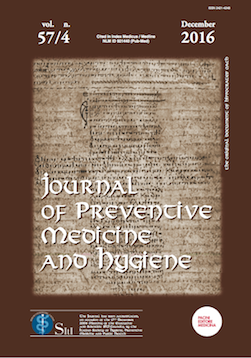Abstract
Introduction. Hand decontamination with alcohol-based antiseptic agents is considered the best practise to reduce healthcare associated infections.
Methods. We present a new method to monitor hand hygiene, introduced in a tertiary care pediatric hospital inNorthern Italy, which estimates the mean number of daily hand decontamination procedures performed per patient. The total amount of isopropyl alcohol and chlorhexydine solution supplied in a trimester to each hospital ward was put in relation with the number of hospitalization days, and expressed as liters/1000 hospitalization-days (World Health Organization standard), and the mean number of patients hospitalized and expressed as mean estimated number of hand hygiene procedures per patient per day (new method).
Results. The two methods had similar performance for estimating the adherence to correct hand disinfection procedures. The new method identified wards and/or periods with high or low adherence to the procedure and indicated where to perform interventions and their effectiveness. The new methods could result easy-to understand also for non-infection control experts.
Conclusion. This method can help non-infection control experts to understand adherence to correct hand- hygiene procedures and improve quality standards.
References
Girou E, Stephan F, Novara A, Safar M, Fagon JY. Risk factors and outcome of nosocomial infections: results of a matched case-control study of ICU patients. Am J Respir Crit Care Med. 1998;157(4 Pt 1):1151-8. doi: 10.1164/ajrccm.157.4.9701129.
Blot SI, Depuydt P, Annemans L, Benoit D, Hoste E, De Waele JJ, Decruyenaere J, Vogelaers D, Colardyn F, Vandewoude KH. Clinical and economic outcomes in critically ill patients with nosocomial catheter-related bloodstream infections. Clin Infect Dis. 2005;41(11):1591-8. doi: 10.1086/497833.
Marchetti A, Rossiter R. Economic burden of healthcare-associated infection in US acute care hospitals: societal perspective. J Med Econ. 2013;16(12):1399-404. doi: 10.3111/13696998.2013.842922.
World Alliance for Patient Safety. The Global Patient Safety Challenge 2005–2006 “Clean Care is Safer Care”. Geneva, World Health Organization, 2005. Available at: http://www.who.int/patientsafety/events/05/GPSC_Launch_ENGLISH_FINAL.pdf. Accessed on 14/04/2016.
WHO Guidelines on Hand Hygiene in Health Care. First Global Patient Safety Challenge Clean Care is Safer Care. Geneva, World Health Organization, 2009. Available at: http://apps.who.int/iris/bitstream/10665/44102/1/9789241597906_eng.pdf. Accessed on 14/04/2016.
Voss A, Widmer AF. No time for handwashing!? Handwashing versus alcoholic rub: can we afford 100% compliance? Infect Control Hosp Epidemiol. 1997;18(3):205-8. doi: 10.2307/30141985.
Pittet D, Hugonnet S, Harbarth S, Mourouga P, Sauvan V, Touveneau S, Perneger TV. Effectiveness of a hospital-wide programme to improve compliance with hand hygiene. Infection Control Programme. Lancet. 2000;356(9238):1307-12. doi:10.1016/S0140-6736(00)02814-2. Erratum in: Lancet. 2000;356(9248):2196. doi:10.1016/S0140-6736(05)67278-9.
Measuring Hand Hygiene Adherence: Overcoming the Challenges. Geneva, World Health Organization, 2009. Available at: http://www.jointcommission.org/assets/1/18/hh_monograph.pdf. Accessed on 14/04/2016.
Boyce JM. Hand hygiene compliance monitoring: current perspectives from the USA. J Hosp Infect. 2008 Oct;70 Suppl 1:2-7. doi: 10.1016/S0195-6701(08)60003-1.
Centers for Disease Control and Prevention. Principles of Epidemiology in Public Health Practice Third Edition. An Introduction to Applied Epidemiology and Biostatistics. October 2006 Updated May 2012. Available at: http://www.cdc.gov/ophss/csels/dsepd/ss1978. Accessed on 19/05/2016.
Pittet D, Allegranzi B, Sax H, Dharan S, Pessoa-Silva CL, Donaldson L, Boyce JM; WHO Global Patient Safety Challenge, World Alliance for Patient Safety. Evidence-based model for hand transmission during patient care and the role of improved practices. Lancet Infect Dis. 2006;6(10):641-52. doi:10.1016/S1473-3099(06)70600-4.
Haas JP, Larson EL. Measurement of compliance with hand hygiene. J Hosp Infect. 2007 May;66(1):6-14. doi:10.1016/j.jhin.2006.11.013.
Sypsa V, Psichogiou M, Bouzala GA, Hadjihannas L, Hatzakis A, Daikos GL. Transmission dynamics of carbapenemase-producing Klebsiella pneumoniae and anticipated impact of infection control strategies in a surgical unit. PLoS One. 2012;7(7):e41068. doi: 10.1371/journal.pone.0041068.

